Research Article
Zinc Metal at a New ZnO Nanoparticles Modified Carbon Paste Electrode: A Cyclic Voltammetric Study
Emad Salaam Abood* Amer Mousa Jouda, Muthana Saleh Mashkoor
Department of Chemistry, Faculty of Science, University of Kufa, 54001 AnNajaf, Iraq.
* Corresponding author. E-mail: amadiraq45@gmail.com
Received: Apr. 7, 2018; Accepted: May 15, 2018; Published: May 23, 2018
Citation: Emad Salaam Abood, Amer Mousa Jouda, and Muthana Saleh Mashkoor, Zinc Metal at a New ZnO Nanoparticle Modified Carbon Paste Electrode: A Cyclic Voltammetric Study. Nano Biomed. Eng., 2018, 10(2): 149-155.
DOI: 10.5101/nbe.v10i2.p149-155.
Abstract
A new carbon paste electrode modified with ZnO nanoparticles was prepared and used to study the electro oxidation of zinc ions in solution by cyclic voltammetry (CV) method. The modified electrode displayed strong resolving function for the overlapping voltammetric response of zinc into one well-defined peak. The potential difference between Epa and Epc was > 200 mV, the range of which referred to the quasi-reversible mechanism. The kinetic of electrode was studied in the range of temperature 15 - 30 oC. The data of voltamograms showed the negative shift increased with increase of temperature, the result of which referred to the diffusion electron transfer in redox process of zinc oxidation. Diffusion coffining was calculated from Sevcik-Randles equation and thus equaled to 1.01 × 10-7. The rate constant was equal to 5.2 x10-8 and 3.3 x 10-8 for oxidation and redaction respectively. And the peak current of zinc increased linearly with its concentration in the range of 2.0 - 20.0 ppm.
Keywords: Cyclic voltammetry; Electrode; ZnO nanoparticales; Hydrothermal method
Introduction
Drug analysis plays important roles in drug quality control, and has great impact on public health. Therefore, a simple, sensitive and accurate method for the determination of active ingredient is very important [1]. Zinc is a nutrient that people need to stay healthy [2]. Zinc is found in cells throughout the body; it helps the immune system fight off invading bacteria and viruses; however, the change in the concentration may result in many diseases [3]. Thus, a quantitative determination of zinc concentration is significant for developing immune physiological and pharmacological research and life sciences. There are some methods applied for the determination of zinc, such as flow injection [4], fluorimetry [5] and spectrophotometry methods [6]. As an electroactive device, it can also be studied via electrochemical techniques. Some reports showed the electrochemical response of zinc on zinc ion electrode [7-8]. The electro chemical methods using chemically modified electrode have been widely used in sensitive and selective analytical methods for the detection of the trace amounts of biologically important compounds [9-11]. Electrode surface can be modified with metal nanoparticles and such surfaces have found numerous applications in the field of bio electrochemistry, particularly in biosensors. It has also been observed that nanoparticles can act as conduction centers facilitating the transfer of electrons. In addition, they provide large catalytic surface area. Many kinds of nanoparticles, including metal nanoparticles, oxide nanoparticles, semiconductor nanoparticles and even composite nanoparticles have been widely used in electrochemical sensors and bio sensors [12]. Zinc is electro active component that can be determined electrochemically [13]; however, it is very difficult to distinguish its response signals at bare electrodes because of their similar potential and interference from each other. Therefore, it is very important to develop a modified electrode to resolve the voltammetric response from each other. To the best of our knowledge, no study has been reported so far on the simultaneous determination of zinc by using carbon paste electrode modified with ZnO nanoparticles. In this research, we report the preparation and application of a carbon paste electrode modified with ZnO nanoparticles for determination of zinc ion without any additional modification such as addition of electron transfer mediator or specific reagent for the first time.
Experimental
Apparatus and chemicals
The electrochemical measurements were performed with an Auto Lab Potentiostat (Digi-Ivy 2113 Texas, USA) controlled by the General Purpose Electrochemical System Software. The ZnO nanoparticle carbon paste electrode was used as the working electrode. A calomel electrode and a platinum (Pt) wire were employed as the reference electrode and counter electrode, respectively, and all potentials were reported with respect to the former. A Metrohm pH/ion meter was used for pH measurement. All solutions were freshly prepared with doubly-distilled water (conductivity of water was 0.055 µS/cm). All reagents were of analytical grade from Merck; graphite powder and paraffin oil both from Merck were used as received. High dilution of acids and bases was in the pH range of 2.0 - 8.0. All solution were deoxygenated with pure nitrogen gas for about 20 min prior to each electrochemical experiment.
Preparation of ZnO nanoparticle by hydro-thermal method
ZnO nanoparticles were synthesized by hydrothermal method. Typically, 13 g of ZnCl2 was dissolved in 300 mL of distilled water, and then a solution containing 8 g of NaOH was slowly added with stirring. After 8 h, a white precipitate was obtained. The resulting precipitate was washed with distilled water and dissolved again in water to get solution, which was mixed with 50 mL of polyvinylpyrrolidone (PVP) (13g of PVP dissolved in water) solution during a continuous stirring to get a homogeneous solution. The homogeneous solution was transferred into autoclave and heated at 160 oC for 8 h. Then ZnO powder was obtained and dried at 100 oC after it had been washed with distilled water. TEM INSPECT S50, was used to determine the morphology of the synthesized ZnO sample. The morphology of the prepared ZnO was studied by transmission electron microscopy (TEM) (Fig. 1). The TEM image showed the agglomerated ZnO particles had an average size equal to 200 nm [15].
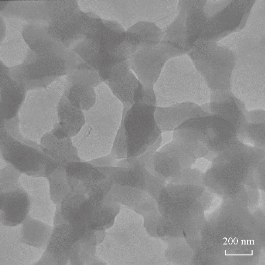
Fig. 1 TEM image of ZnO nanoparticles.
Preparation of the electrode
The ZnO modified carbon paste electrodes were prepared by mixing 0.1 g of ZnO nanoparticles, 0.9 g of graphite powder and 0.7 mL of paraffin oil with a mortar and pestle until a uniform paste was obtained. The paste was packed into the end of a glass tube (cross-section area 0.44 mm2 and length 10 cm). The electrical contact was provided by inserting a copper wire into the carbon paste. Prior to the experiment, the surface of the carbon paste was polished with fine paper. The unmodified carbon paste electrode was prepared in the same way without adding ZnO nanoparticles to the paste.
Result and Discussion
Cyclic voltammetry study of zinc
Fig. 2 depicts the cyclic voltammetric response for the electrochemical oxidation-reduction of 0.1 mol ZnSO4 at ZnO nanoparticle carbon paste electrode. The anodic peak potential for the oxidation of Zn+2 and the reduction peak were about -1.261 V and -0.920 V, respectively. While no response was observed on the carbon paste electrode (Fig. 2b). The result clearly indicated that the combination of graphite powder with ZnO nanoparticle improved zinc oxidation signal. The effect of scan rate on the electro-oxidation of zinc at the ZnO nanoparticle carbon paste electrode was investigated by cyclic voltammetry (CV) (Fig. 3). A plot of peak current (Ip) versus the square root of scan rate (V1/2) in the range of 0.1 - 5 V/s was linear. This suggested that, at sufficient overpotential, the process was diffusion rather than surface control [14].
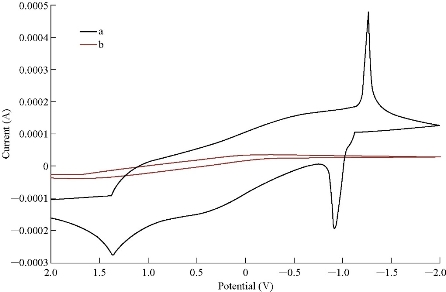
Fig. 2 Cyclic voltammogram of (a) ZnO nanoparticle carbon paste electrode and (b) carbon passed electrode in 0.1 mol ZnSO4 solution at the scan rate of 0.1 V/s.
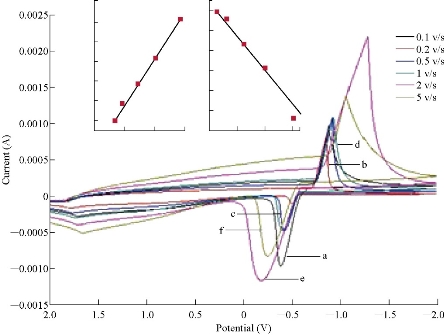
Fig. 3 Cyclic voltammogram of ZnO nanoparticle electrode in the presence of 0.1 mol of ZnSO4 solution at different scan rates of (a) 0.1, (b) 0.2, (c) 0.5, (d) 1, (c) 2 and (f) 5 V/s, respectively.
Temperature dependence study on the electro-oxidation of ZnO nanoparticle electrode
A study of the electro-oxidation on electrodes was carried out with CV in the temperature range from 15 oC to 30 ºC with calomel electrode; the best condition of 18 - 25 ºC was used for calomel electrode [15]. The variation of the cyclic voltammogram (j-E) curves allowed the determination of activation energy in a wide interval of potentials where characteristic oxidation peaks appeared. Stationary current intensity measurements allowed the determination of the activation energy in pure kinetic region conditions. Temperature dependence of the charge-transfer resistance and the rate were constantly associated with the surface coverage by a diffusion intermediate during the electro-oxidation process, which was evaluated and discussed, suggesting that a complex mechanism took place for the electro-oxidation free of strong interactions with the ZnO nanoparticle electrode surface [16]. Result referred to the working electrode tacked the clear signal with Nernst equation (eq. (1)) at 15 - 30 oC [17]:
ln D = ln Do - ![]() , (1)
, (1)
where D is the diffusion coefficient, T is the temperature, and K is the kelvin. From the slop between ln D and 1/T K shown in Fig. 4, the free energy was calculated and equal to Ea = 68.94 KJ/mol. This result revealed the exothermic reaction accrued when potential was provided on the working electrode, by equation (2) [18]:
∆G = -nFR(∆Ep), (2)
where ∆G is the free energy, F is the Faraday constant, R is the gas constant, and Ep is the difference in potential. The free Gibbs energy was determined as of 58.7 KJ/mol, which referred to the spontaneous reaction. From last result, the constant of reaction Kp was calculated by used Nicholson equation (eq. (3)) [19]:
K = Ko exp![]() (E - Eo). (3)
(E - Eo). (3)
1.43 × 10-5 V/s for the quasi-reversible reaction of cyclic voltammtry referred to the first order reaction. Table 1 shows the kinetic and thermodynamic parameter for the ZnO nanoparticle carbon paste electrode.
Table 1 Kinetic and thermodynamic parameters for ZnO nanoparticle carbon paste electrode
|
Type of electrode |
∆E KJ/mol |
∆H KJ/mol |
∆G KJ/mol |
∆S J/mol |
K0Oxd/s |
K0Red/s |
α |
Do 10-7 |
|
ZnO nanoelectrod |
-37.904 |
32.4 |
58.7 |
70.8 |
5.2 - 10-8 |
3.2 - 10-8 |
0.5 |
1.01 |
Note: ∆E = energy; ∆H = enthalpy; ∆G = free energy; ∆S = entropy; K0Oxd/s = rate constant; α = transported coefficient; Do10-7 = diffusion coefficient.
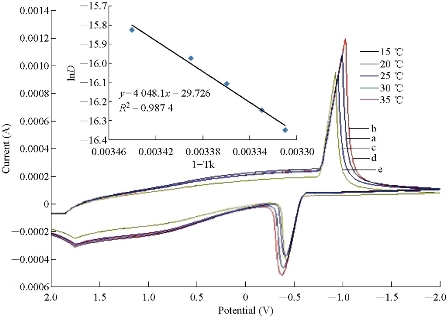
Fig. 4 Effect of temperature on the cyclic voltammogram for ZnO nano electrode as at (a) 15, (b) 20, (c) 25, (d) 30 and (e) 35 ℃, respectively. The ln D - 1/T k plot for the calculation of Ea energy for ZnO nanoparticle electrode.
Calibration plots and determination of zinc in ZnO nanoparticle carbon paste electrode
Cyclic voltammetry was used to obtain the analytical features of the method such as linear ranges of the calibration plots and to detect the limits for Zn2+ [20]. Capability of separating the electrochemical response of Zn2+ by ZnO nanoparticle modified electrode was studied. Therefore, CV was used for the simultaneous determination of species based on its superior elimination of the capacitive background current. Analytical experiments were carried out by varying concentrations of ZnSO4 pure stock solution with pH 7.0 by using ZnO nanoparticle electrode. Fig. 5 shows the calibration curve by CV obtained at 2 - 20 ppm, clearly revealing the response of the ZnO nanoparticle to Zn2+. Table 2 and 3 show the results for stock solution and real sample of zinc (Hasanl A – Z VITAL, Germany) that contained vitamins A, C and E, folic acid, lutein, calcium, phosphorus, copper, iron and zinc with composition percentages of 40, 10, 20, 10, 5, 5, 5 and 5%, respectively. Equation 4 was used to prepare the measurement solutions:
w.t = ![]() . (4)
. (4)
All results pointed out that ZnO electrode was more sensitive than colorimetric and atomic analyzer for determination of trace amount in drug component.
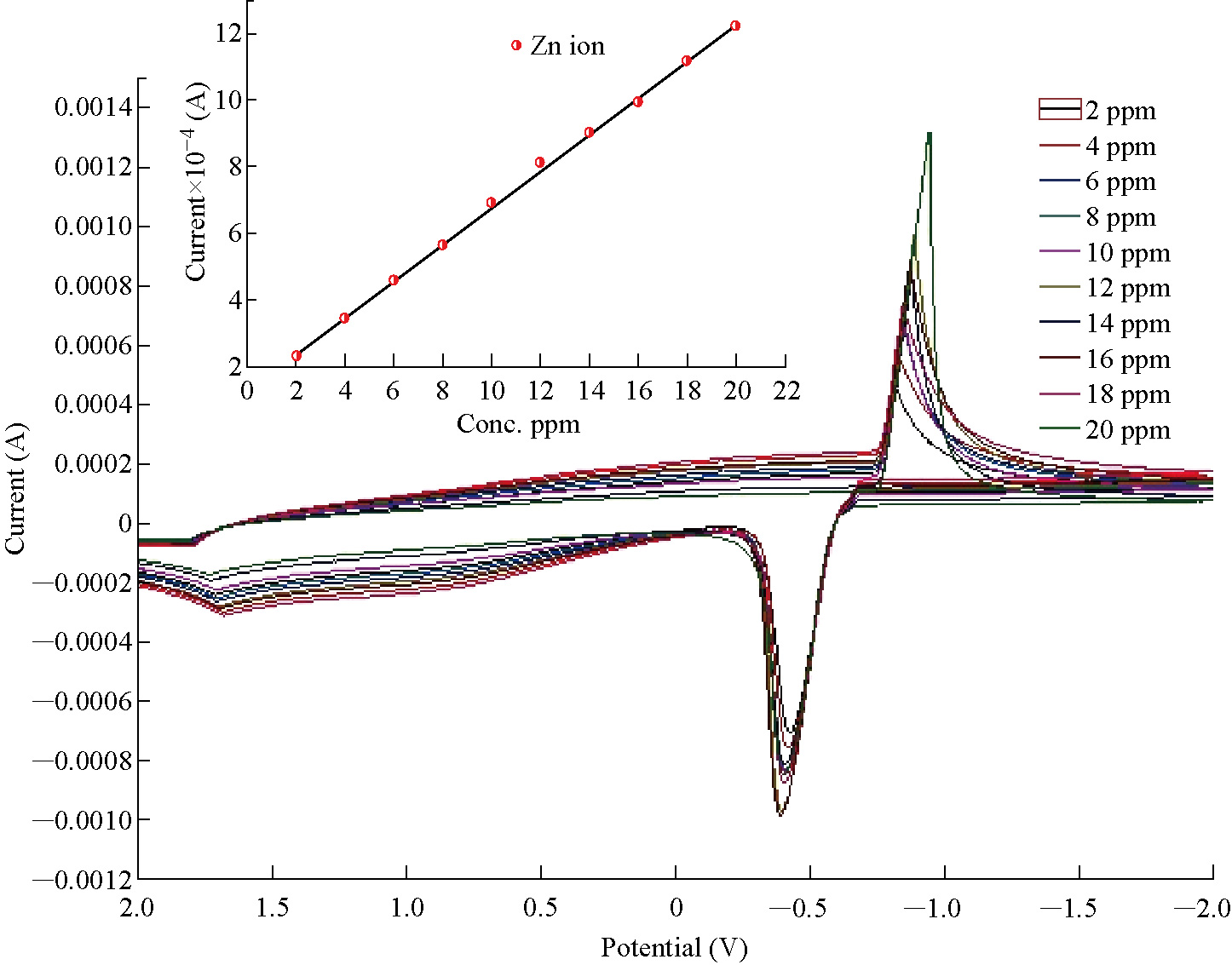
Fig. 5 Cyclic voltammograms and calibration curve by ZnO nanoparticle electrode for ZnSO4 stock solutions.
Table 2 Determination of real stock solution by deferent methods
|
Method |
Analyte (Zn/mg) |
Linear range (ppm) |
Founded (ppm) |
RSD (%) |
Theoretical value (ppm) |
|
Cyclic voltammetry |
-- |
10-3 - 10+3 |
-- |
-- |
-- |
|
5 |
-- |
4.811 |
96.2 |
5 |
|
|
10 |
-- |
9.641 |
96.4 |
10 |
|
|
15 |
-- |
14.892 |
99.2 |
15 |
|
|
Colometry |
-- |
0.08 - 5 |
-- |
-- |
-- |
|
5 |
-- |
4.625 |
92.5 |
5 |
|
|
10 |
-- |
9.231 |
92.3 |
10 |
|
|
15 |
-- |
14.612 |
97.4 |
15 |
|
|
Atomic radiation |
-- |
0.1 -10+3 |
-- |
-- |
-- |
|
5 |
-- |
4.791 |
95.2 |
5 |
|
|
10 |
-- |
9.611 |
96.1 |
10 |
|
|
15 |
-- |
14.861 |
99.0% |
15 |
Note: RSD = relative standard deviation.
Table 3 Determination of real drug samples by deferent methods
|
Method |
Analyte (Zn/mg) |
Linear range (ppm) |
Founded (ppm) |
RSD (%) |
Theoretical value (ppm) |
|
Cyclic voltammetry |
-- |
10-3 - 10+3 |
-- |
-- |
-- |
|
5 |
-- |
3.912 |
78.2 |
5 |
|
|
10 |
-- |
8.101 |
81.0 |
10 |
|
|
15 |
-- |
12.301 |
82.0 |
15 |
|
|
Colometry |
-- |
0.8 - 50 |
-- |
-- |
-- |
|
5 |
-- |
3.111 |
62.2 |
5 |
|
|
10 |
-- |
7.315 |
73.1 |
10 |
|
|
15 |
-- |
11.012 |
73.4 |
15 |
|
|
Atomic radiation |
-- |
0.1 -10+3 |
-- |
-- |
-- |
|
5 |
-- |
3.900 |
78.0 |
5 |
|
|
10 |
-- |
8.011 |
80.1 |
10 |
|
|
15 |
|
12.021 |
80.1 |
15 |
Conclusions
Nano zinc oxide is a highly sensitive and selective vehicle that senses the small changes in the current passing through its solution when it becomes an electrode. Therefore, it was used to prepare the electrode and to study its physical and chemical properties. It was applied to measuring the small concentrations of some drugs containing zinc. The results were highly accurate in standard solutions and in real samples when compared to common methods such as atomic analysis and colorimetric method.
Conflict of Interests
The authors declare that no competing interest exists.
References
Copyright© Emad Salaam Abood, Amer Mousa Jouda, and Muthana Saleh Mashkoor. This is an open-access article distributed under the terms of the Creative Commons Attribution License, which permits unrestricted use, distribution, and reproduction in any medium, provided the original author and source are credited.